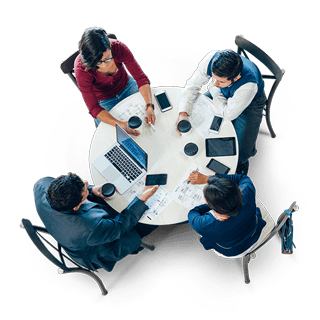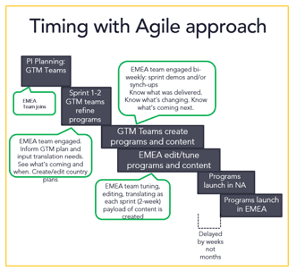
Like many organizations, Planview operates globally, with headquarters in Austin, Texas, and offices in Stockholm and Bangalore. About two years ago, we launched a company-wide initiative to rewire our organization and embrace Agile ways of working—not just in product and R&D, but across every department and team, starting with marketing. We developed three go-to-market (GTM) teams, whose goals and objectives centered around building marketing campaigns to create a pipeline for sales. Each team aligned to a different buyer group, with members from the product, marketing, and sales.
The challenge: integrating international teams in our Agile transformation
Like many organizations, we struggled to align and execute our marketing programs across our international teams, defaulting to “North-America-first efforts” that other regions were then left to replicate. As we built out these new groups, we considered how to best include our five-person team of regionally aligned field and demand marketers in Europe, the Middle East, and Africa (EMEA).
At the beginning of our Agile transformation, the EMEA marketers were often misaligned and disconnected from big-picture plans. The EMEA teams were running different campaigns from those in North America. Before forming cross-functional GTM teams, the EMEA team had to individually meet with the different functions in marketing, product marketing, and other departments. The extra complications of time zones and cultures also made it difficult to get things done and stay on strategy.
With team members feeling disconnected, at Planview we suffered lower-impact campaigns and less-than-ideal demand generation. To succeed in our Agile transformation journey, it was critical to properly align the international team through an integrated Agile program management strategy.
The approach: forming and integrating the EMEA team into Agile program management
While the three GTM teams had dedicated cross-functional members representing demand generation, content strategy, and product marketing, it was clear that assigning an EMEA team member to each of these teams wouldn’t solve the problem. Each EMEA marketer is organized by region and language, not by GTM Agile Release Train (ART), so we needed to develop our own EMEA Agile program that would meet the challenges and achieve the needed international alignment.
Working with our Chief Marketing Officer and other stakeholders, we determined that we would continue to align our EMEA team by region/language. Now that the GTM teams were formed (with each team having all the necessary people to deliver end-to-end value), the EMEA team could meet with each team in the context of the prioritized strategic initiatives. Drawing on our local expertise, we could weigh the campaigns from the three GTM teams against each other to determine which would drive the most pipeline and impact in each region. This structure enabled EMEA marketers to opt into GTM campaigns that were regionally impactful, instead of creating standalone campaigns. This approach has been a success. At our last PI planning event, EMEA progressed from just replicating campaigns into co-planning and co-creating the campaigns that were of local interest and fit.
By including the distributed teams in Agile program management, we achieved better alignment as a global marketing team; gave our EMEA marketers the opportunity to leverage fully supported, regionally impactful campaigns; and ultimately, achieved better results for our demand generation campaigns.

Learning 1: When starting the process of shifting to an Agile approach, there is an advantage in letting the GTM team form, storm, and norm before involving the EMEA team. That delay allows for the EMEA team to finish up previously committed (sales-agreed-upon) deliverables. It gives the team and the sales stakeholders time to observe and see the benefits of Agile GTM teams without feeling that they are not getting the support they were expecting.
The practice: virtual, inclusive PI planning
Our model continues to evolve in a positive way. We’ve now been through five PI planning events and have transitioned from a “one EMEA representative” approach to including our full marketing team in a truly global planning event.
What does a global planning event look like in practice?
When our EMEA team started to participate in PI planning, we had one representative join to understand the process and feed the critical milestones into the team’s plans. We then matured to the full team joining remotely, which meant that we needed to create a system that would enable inclusive planning across continents.
We created a process of “continuous planning.” First, our global team would plan “together,” from Austin and virtually via web conferencing for EMEA. Our EMEA teams would log off during the evenings in their time zones, and the US team would continue to plan with recorded readouts. The next morning, while the US teams were offline, the EMEA teams would listen to the readouts, adapt plans accordingly, and provide their own readouts on changes made once the team was back together during mutual business hours. While tricky at first, this process ensured that everyone was engaged and that all teams’ contributions were heard and considered. Most recently, we’ve conducted fully virtual planning in mutual time zones.
Learning 2: The gradual inclusion in PI planning meant the GTM teams were already well-established and well-versed in the process. The maturity of the teams and the process helped a lot in the inclusion of the international team.
The results: greater alignment, faster time-to-market, better campaigns

The impact of our EMEA Agile program can be broken down into three main categories: alignment, time, and utilization.
The collaboration between the EMEA and GTM teams has created significantly stronger connection and alignment, evidenced by both the improvement in campaign quality and our working practices. Our teams have increased visibility into shared and separate work and developed a better understanding of how decisions impact overarching shared goals.
Our Agile ceremonies, combined with the use of Planview LeanKit, have served as a catalyst and a framework to bring us closer together. Communication is easier, more frequent, and more productive, as everyone is aligned to the same goals and plans and has visibility into each other’s progress, needs, and capacity. The greater team can now make conscious trade-offs based on mutual priorities, which enables the EMEA team to focus on the right things and deemphasize asks that are not aligned to the goals. EMEA marketers feel more involved and have an important seat at the table. That is both motivating and effective.
Learning 3: Ceremonies and visual planning tools are absolutely necessary, but only really benefit teams with the right enablement and coaching. To this day we still meet weekly with our Agile coach to refine our LeanKit board and discuss WIP limits, sizing, retros, etc.
From a time-to-market perspective, we’ve seen substantial improvements. Before aligning EMEA to the GTM teams, there were delays in deploying campaigns because EMEA would “find out” about campaigns rather than being part of them from the beginning. Now, the team can give early input and feedback on how a campaign could be adapted to provide the most impact for EMEA, then roll it out more quickly. As a concrete example, we have reduced the time for campaign tactics to go live from three months to three weeks.
The volume and quality of campaigns and campaign materials has increased significantly as well. In the past, the EMEA team often made do with the materials (especially translated materials) that were available, not the assets that were ideal. There were campaign ideas that we could not realize due to a lack of localized material. Without dedicated resources for EMEA, the team had to share creative and translation services with North American providers, who often needed to prioritize programs led by corporate/North America.
Now that EMEA has full visibility into the North American programs, they know what kind of material is in development.
They give input on what is needed to execute campaigns in global markets and when delivery will happen. That means EMEA campaigns can begin at almost the same time as the North American ones, and their marketers can prepare for when translated assets and other materials will be available.
Overall, by transforming our EMEA Agile program, the region went from running one or two campaigns each PI to running five campaigns per PI. EMEA marketing went from approximately four to six new localized assets/materials per year to 18 – 20. We added three translated, campaign-specific landing pages per language. And, most importantly, we’re beginning to see direct indication of pipeline improvements.
Agile program management can be challenging with international, distributed teams. By integrating our global team members into our planning processes from the beginning of our Agile transformation, we’ve been able to achieve measurable benefits across the marketing organization.

About Verena Bergfors

Verena is the Marketing Director for Planview’s EMEA markets. She’s from Germany but moved to Sweden around 10 years ago and has been with Planview for over four years. Prior to living in Sweden, she worked in Shanghai for seven years where she held positions in marketing and sales. Verena’s true passion is languages and she enjoys working on diverse international teams.
Share:
Back to: All Blog Posts
Next: Use WSJF to Inspire a Successful SAFe Adoption